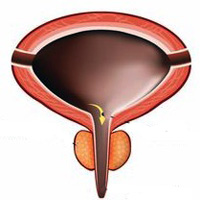Physiopathology of the diabetic bladder

All claims expressed in this article are solely those of the authors and do not necessarily represent those of their affiliated organizations, or those of the publisher, the editors and the reviewers. Any product that may be evaluated in this article or claim that may be made by its manufacturer is not guaranteed or endorsed by the publisher.
Objective: To investigate the incidence of diabetic cystopathy in relation to age, gender, type of diabetes, duration of diabetic disease and clinical evidence of peripheral neuropathy and to analyze the physiopathology of the various forms of diabetic cystopathy due to sensory impairment, motor-sensory impairment, motor impairment and hyperreflexia.
Materials and methods: In a retrospective multicenter cohort study the medical records of a cohort of 126 diabetic patients with (128 patients) or without (48 patients) urological symptoms were analyzed. Patients were observed at the Città di Alessandria Clinic of Policlinico di Monza and/or at the outpatient clinic of Alessandria Hospital from June 2018 to June 2020. The study excluded patients with central and/or peripheral neuropathy, spina bifida (mylomeningocele or meningocele) or spina bifida occulta; with persistent urinary infections; in anticholinergic treatment for enteric dysfunctions; in medical treatment for cervical-prostatic-urethral obstruction; with vaginal and/or rectal prolapse of II, III, IV degree; with previous spinal or pelvic surgery including radical prostatectomy, Wertheim hysterectomy or colorectal surgery. All the patients were studied with computed tomography (CT) scan of the urinary tract, voiding cystourethrography (VCUG), uroflowmetry, cystomanometry with intrinsic pressure assessment and compliance evaluation, electromyography (EMG) of the anal sphincter, pressure flow analysis, urethral pressure profile and, when advised, pharmacological tests.
Results: Out of 126 diabetic patients, 48 did not show any signs or symptoms of urine voiding dysfunction; 30 were men and 18 women with an average age of 62.6 years; 20 had type I diabetes and were in treatment with insulin and 28 type II diabetes treated with oral hypoglycemic medication. The remaining 78 patients (48 men and 30 women), with an average age of 64.8 years, presented urological symptoms; 31 had type I diabetes and 47 had II type diabetes.
Conclusions: Diagnosis of the various forms of diabetic cystopathy and early treatment decreases complications and consequently accesses to outpatient facilities and hospital admissions, resulting in an improved quality of life.
Feldman EL, Callaghan BC, Pop-Busui R, Zochodne DW, Wright DE, Bennett DL, Bril V, Russell JW, Viswanathan V. Diabetic neuropathy. Nat Rev Dis Primers. 2019;5:42 DOI: https://doi.org/10.1038/s41572-019-0092-1
Deli G, Bosnyak E, Pusch G, Komoly S, Feher G. Diabetic neuropathies: diagnosis and management. Neuroendocrinology. 2013;98:267–80. DOI: https://doi.org/10.1159/000358728
Ziegler D. Painful diabetic neuropathy: treatment and future aspects. Diabetes Metab Res Rev. 2008;24 Suppl 1:S52-7. DOI: https://doi.org/10.1002/dmrr.817
Tanik N, Tanik S, Albayrak S, Zengin K, Inan LE, Caglayan EK, Celikbilek A, Kirboga K, Gurdal M. Association between overactive bladder and polyneuropathy in diabetic patients. Int Neurourol J. 2016; 20:232-239. DOI: https://doi.org/10.5213/inj.1632508.254
Duby JJ, Campbell RK, Setter SM, White JR, Rasmussen KA. Diabetic neuropathy: an intensive review. Am J Health Syst Pharm. 2004;61:160-73 DOI: https://doi.org/10.1093/ajhp/61.2.160
Bossi L, Caffaratti E. [Bladder complications in neuropathic diabetic patients. Clinical and radiological study]. Minerva Radiol 1968;13:40–7.
Bradley WE. Cerebro-cortical innervation of the urinary bladder. Tohoku J Exp Med 1980;131:7–13. DOI: https://doi.org/10.1620/tjem.131.7
Bolgeo T. Caring for bladder dysfunctions in patients with Parkinson’s disease. Arch Ital Urol Androl 2011; 83:112–5.
Boccafoschi C, Maurel A. Appunti sui parametri e le metodiche in urodinamica. Minerva Medica; 1986.
Frimodt-Møller C. Diabetic cystopathy: epidemiology and related disorders. Ann Intern Med. 1980;92:318-21 DOI: https://doi.org/10.7326/0003-4819-92-2-318
Freeman R. Diabetic autonomic neuropathy. Handb Clin Neurol. 2014;126:63-79 DOI: https://doi.org/10.1016/B978-0-444-53480-4.00006-0
Carone R, Frea B, Tizzani A, Borgno M. [Neurologic bladder in diabetes. Etiopathogenetics and treatment]. Minerva Urol. 1979;31:91–3.
Kiani J, Moghimbeigi A, Azizkhani H, Kosarifard S. The prevalence and associated risk factors of peripheral diabetic neuropathy in Hamedan, Iran. Arch Iran Med. 2013;16:17–9.
PAGEPress has chosen to apply the Creative Commons Attribution NonCommercial 4.0 International License (CC BY-NC 4.0) to all manuscripts to be published.


 https://doi.org/10.4081/aiua.2020.4.314
https://doi.org/10.4081/aiua.2020.4.314



